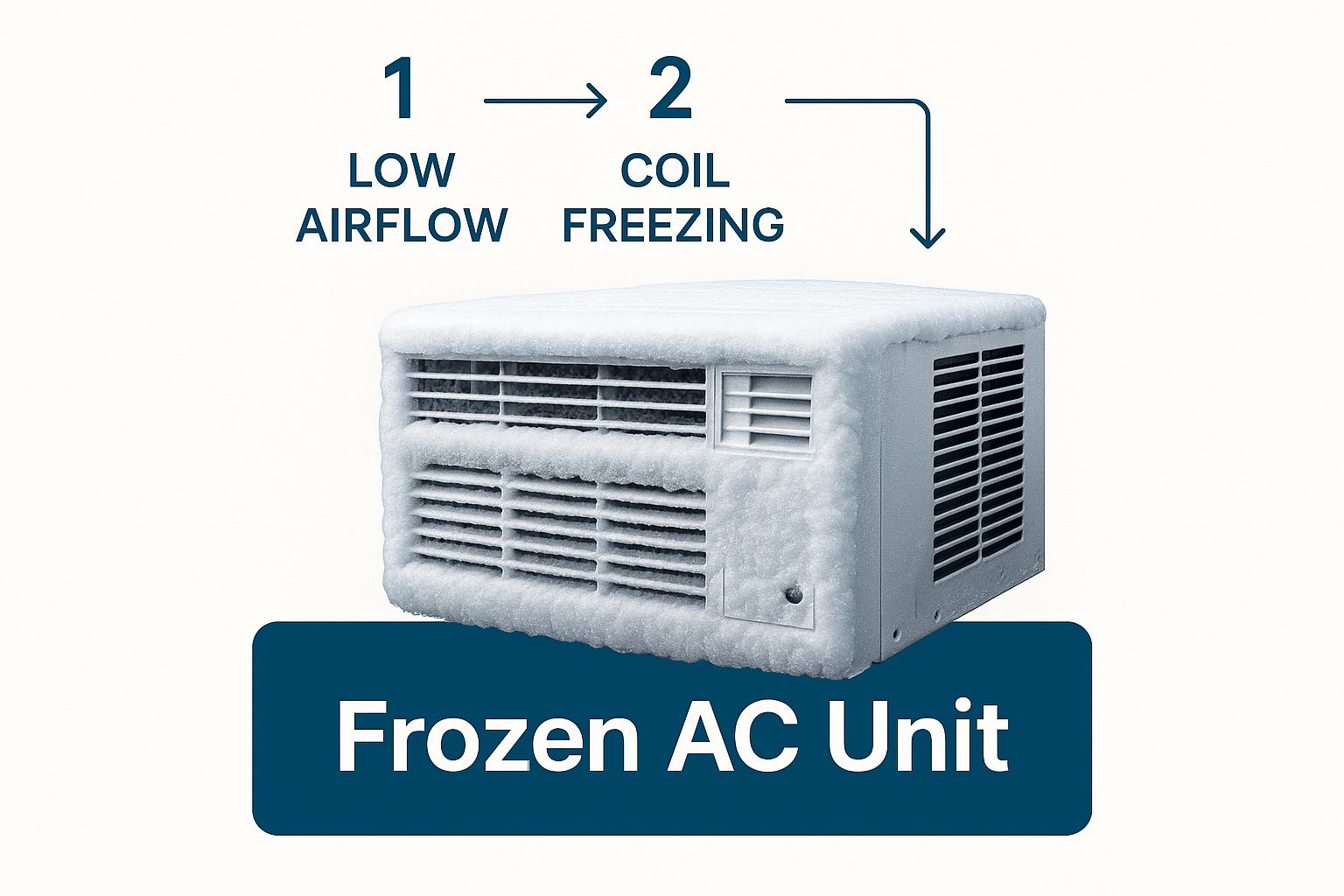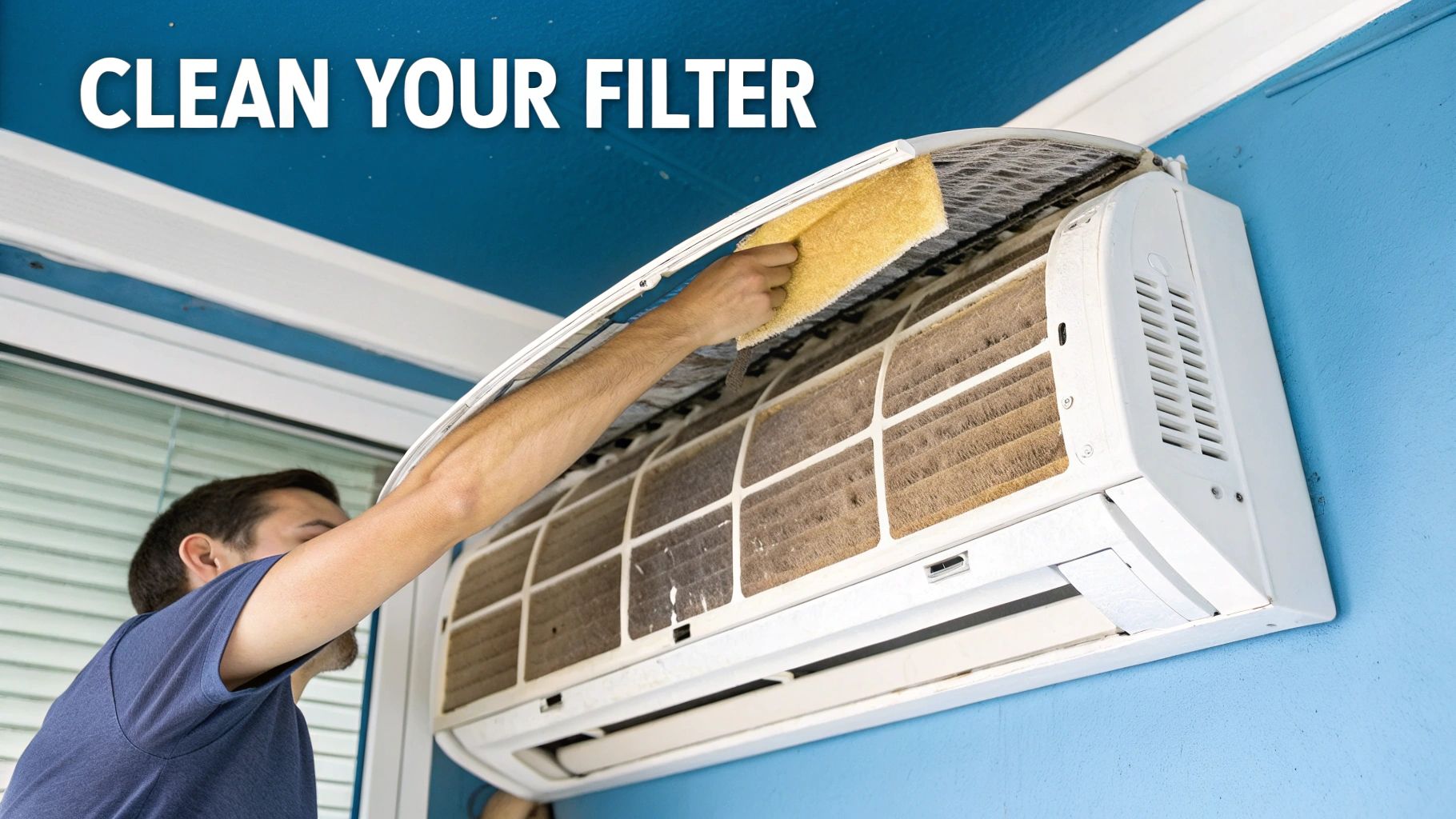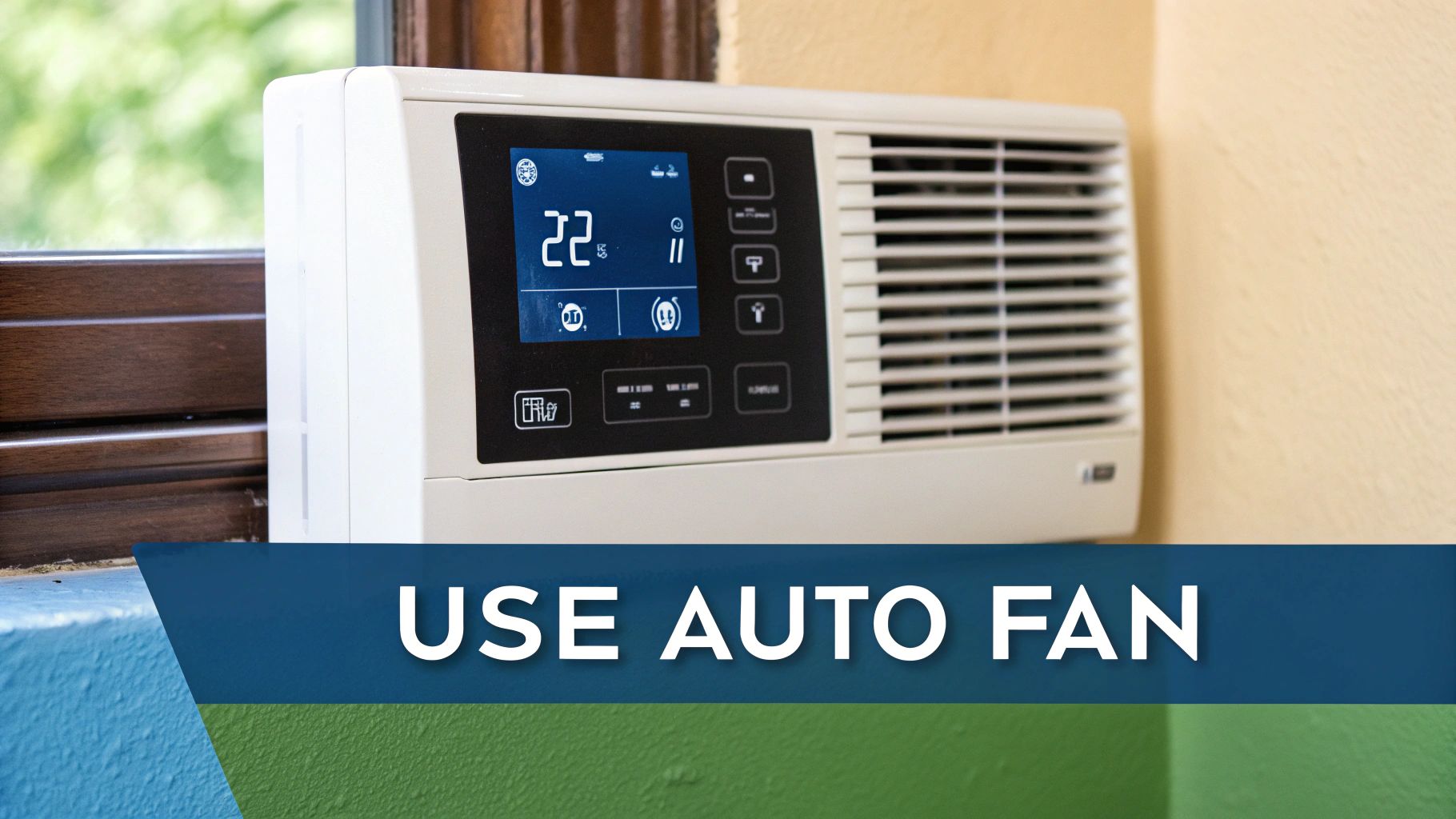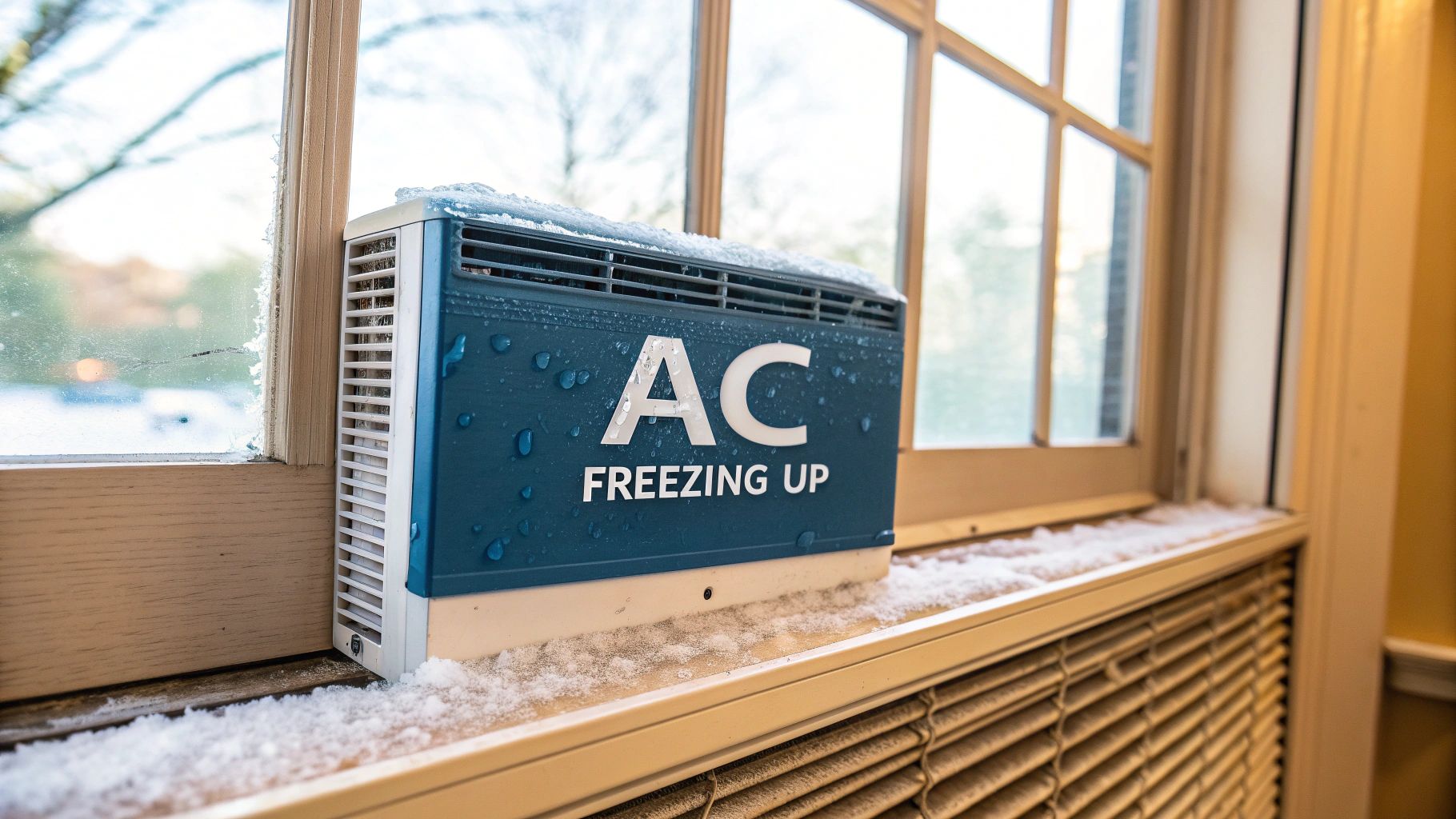Walking into a room on a sweltering day only to find your window AC unit covered in a sheet of ice is more than just frustrating—it’s a clear sign something is wrong. But don't panic. This is a common issue, and it's usually something you can troubleshoot yourself.
The problem almost always comes down to one of two things: restricted airflow or low refrigerant. Either way, the end result is the same. The evaporator coils inside your unit get far too cold, causing the moisture that would normally drip away as condensation to flash-freeze into a solid block of ice.
Your Window AC Is a Block of Ice. Here Is What Is Happening.
That icy buildup isn't just a weird quirk; it’s a symptom of an unbalanced cooling process. For your AC to cool your home, it needs a constant flow of warm indoor air to pass over its ice-cold evaporator coils. When something gets in the way of that airflow, the coils don't absorb enough heat, their temperature plummets, and any humidity in the air instantly freezes onto them.
This is what it looks like when things have gone wrong—a familiar sight for anyone who's dealt with this before.

What you see here is the end result of an internal issue, turning your essential cooling appliance into a useless, inefficient ice block.
Finding the Root Cause
Before you can get things running smoothly again, you have to play detective and figure out what’s causing the freeze-up. The culprits usually fall into a few common categories, from simple maintenance you can do in minutes to more complex mechanical problems.
- Airflow Obstructions: This is, by far, the most common reason. We're talking about a clogged air filter, blocked vents, or even furniture and curtains pushed up right against the unit.
- Refrigerant Leaks: If your system is low on refrigerant, the pressure inside the coils drops dramatically. This causes them to become excessively cold, leading to a rapid freeze.
- Incorrect Settings: Believe it or not, you can create the perfect storm for ice. Running the AC on its coldest setting with the fan on low, especially on a cool, humid night, is a classic recipe for a frozen unit.
The most important thing to remember is that the ice is a symptom, not the actual problem. Just letting the unit thaw out without fixing the underlying issue means the ice will be back in no time. Worse, this cycle can put immense strain on the compressor—the heart of your AC and its most expensive component.
To help you get to the bottom of it faster, here’s a quick way to diagnose the problem based on what you’re seeing and hearing.
Quick Diagnosis for a Frozen Window AC
Use this table to quickly identify the likely cause of the freezing, what to look for, and how to approach the fix.
| Likely Cause | What You Will Notice | Typical Fix |
|---|---|---|
| Blocked Airflow | Weak or no air coming from vents; visible dirt on the filter. | Clean or replace the air filter; clear obstructions. |
| Low Refrigerant | Hissing sounds; oily residue on coils; ice reappears quickly after thawing. | Call a professional HVAC technician for repair. |
| Faulty Thermostat | AC runs constantly without shutting off; inconsistent temperatures. | Check sensor placement; may require professional repair. |
By narrowing down the possibilities, you can decide whether it's a quick DIY fix, like cleaning a filter, or if it’s time to call in a pro to handle something more serious like a refrigerant leak.
Checking for the Most Common Cause: Blocked Airflow
When you see ice on your window AC, it's easy to jump to the worst-case scenario—a costly repair bill. But before you panic, take a breath. In my experience, the vast majority of freezing issues, probably 90% of them, boil down to one simple thing: blocked airflow.
Your air conditioner needs to constantly pull in warm room air to function correctly. When something gets in the way, the internal components get too cold, and that's when ice starts to form. The good news? This is usually something you can fix yourself in just a few minutes.
Let's start with the most likely suspect.

Start With the Air Filter
The first and most important place to look is the air filter. It's designed to catch all the dust, pet hair, and other junk floating around in your air. But once it’s full, it starts to suffocate your AC unit. The system can no longer pull in enough warm air to keep the evaporator coils from freezing over.
Slide off the front panel of your unit and pull out the filter. If it looks like a fuzzy, gray blanket, you’ve probably found your culprit.
- If you have a washable filter: Just take it outside, tap out the loose stuff, and give it a good rinse with some mild soap and warm water. The key is to let it dry completely before putting it back in. A damp filter is a perfect breeding ground for mold.
- If you have a disposable one: Toss it and slide a new one in. A good habit is to grab a marker and write the date on the filter’s cardboard frame so you remember when you last changed it.
Blocked airflow is such a common problem, and getting the filter right is a huge part of AC maintenance. For a deeper dive, you can find some excellent guidance on filter replacement from other pros. And if you're ever curious about the different kinds available, we've got a great resource on the best https://floridacoolinggroup.com/filters-for-air-vents-in-home/ for your setup.
Look for Other Airflow Obstructions
Sometimes the filter is clean, but something else is getting in the way. Take a quick look around the unit, both inside your room and outside the window.
Is a big piece of furniture, like a couch or a bookshelf, pushed right up against the unit? Are your drapes getting sucked against the vents when it's running? These common household items can be enough to restrict airflow and cause a freeze-up.
A Quick Rule of Thumb: Try to keep at least a foot of clear space around the front and sides of the indoor part of your AC. This gives it plenty of room to breathe and do its job properly.
Inspect the Evaporator Coils
If the filter is clean and nothing is blocking the vents, the next stop is the evaporator coils. These are the delicate metal fins you see sitting right behind the filter. Even with a clean filter, a fine layer of sticky dust and grime can build up on the coils themselves over time.
First, unplug the unit. You don’t want it kicking on while your hands are in there.
Then, using a soft-bristle brush (an old toothbrush works great) or a can of compressed air, gently clean the fins. They bend very easily, so be careful. This simple cleaning can make a world of difference, restoring the airflow needed to stop the icing. In fact, research shows that simply ensuring clear airflow can cut the chances of a unit freezing by up to 50%.
When to Suspect a Refrigerant Problem
So, you've done everything right. You diligently cleaned the filter, scrubbed the coils, and made sure nothing is blocking the airflow. But that stubborn layer of ice just keeps coming back. When this happens, it’s time to consider a more serious culprit: a refrigerant leak.
It’s a common myth that air conditioners "use up" refrigerant like a car burns through gas. That’s simply not the case. The refrigerant is in a sealed, closed-loop system. If the level is low, it can only mean one thing—there’s a leak somewhere.
Telltale Signs of a Refrigerant Leak
A window AC freezing because of a refrigerant issue will give you a few distinct clues. These aren't like the weak airflow you get from a clogged filter. Instead, you’ll need to use your eyes and ears to play detective.
Keep an ear out and an eye open for these classic symptoms:
- Hissing or Bubbling Noises: Do you hear a faint hissing sound when the unit is running? That could be refrigerant gas escaping from a tiny crack in the coils. A gurgling or bubbling sound can also signal a leak.
- Oily Residue: Refrigerant is mixed with a special oil to keep the compressor lubricated. If you spot a greasy film on the copper tubing or coils, that's a dead giveaway that both oil and refrigerant are seeping out.
- Weak Cooling Performance: Long before it freezes over, a unit low on refrigerant just won't cool the room properly. It might run constantly without ever hitting the temperature you set on the thermostat.
A low refrigerant level is an incredibly frequent cause of AC trouble. Industry reports show that improper refrigerant levels are behind over 75% of air conditioning problems that result in frozen coils. Even a small drop of just 10% in refrigerant can slash your AC's efficiency by 20%, which is why a slow leak almost always leads to a freeze-up. You can find more expert insights on common AC issues from the pros at Trane.
This is the point where you absolutely must stop any DIY work. Handling refrigerant is dangerous and requires specialized tools, training, and an EPA certification. Trying to fix a leak or add refrigerant yourself can wreck your AC unit, and it's illegal without the proper credentials.
The Recurring Ice Pattern
One of the most surefire signs of a slow refrigerant leak is the pattern of freezing. You’ll thaw the unit completely, clean it until it shines, and it will work perfectly for a few days, maybe even a week. Then, out of nowhere, a small, concentrated patch of ice shows up on the evaporator coils.
This frustrating cycle happens because the system loses just enough refrigerant to cause a pressure drop, which triggers the freezing. As more refrigerant leaks out, that patch of ice will get bigger and appear more quickly after each time you thaw it.
If this sounds familiar, it's a clear signal that the problem is internal. Your next step should be calling a qualified HVAC technician.
How Your Thermostat and Fan Settings Can Accidentally Cause Freezing
Sometimes, the reason your window AC is freezing up isn't due to a broken part or a clogged filter. The culprit can be something as simple as the settings you're using. I see this all the time, especially on those cooler, humid nights when you might crank the AC way down, unknowingly creating the perfect storm for ice buildup.
Here's the deal: your AC's evaporator coils need a constant flow of warm air to keep them from dropping below freezing. The fan's job is to pull that warm room air over the coils. When you set the thermostat to its coldest setting but leave the fan on 'Low,' you create an imbalance. The coils get frigid, but the fan isn't moving enough warm air across them to keep the condensation from turning into ice.

Finding the Sweet Spot for Your Settings
The trick is to avoid pushing your unit to its absolute limits. You’ll get better, more consistent cooling by maintaining a reasonable temperature with good airflow, rather than trying to create an arctic blast that just ends up freezing the unit. It’s a classic case of working smarter, not harder. In fact, studies on smart thermostats show they can slash energy use by up to 12% a year, mostly by optimizing these settings to avoid overworking the system. If you want to dive deeper, you can learn more about how technology prevents AC freezing and pick up other helpful insights.
Here are a few practical tweaks you can make right now:
- Don't Go for the Deep Freeze: Instead of setting the AC to 62°F on a mild 75°F night, aim for a more balanced 68°F. This gives the compressor a chance to cycle off instead of running constantly.
- Let the Fan Do Its Job: Always opt for the 'Auto' or 'High' fan setting. This ensures plenty of air is moving across the coils, which is your best defense against ice.
- Embrace 'Energy Saver' Mode: This setting is your friend. It cycles the whole system on and off to hold your target temperature, giving the coils a natural break from getting too cold.
A Quick Look at the Thermostat Sensor
Here’s another sneaky issue I’ve run into: a misplaced or dirty thermostat sensor. This is the little copper or silver wire you’ll see poking out from behind the filter, right near the evaporator coils. Its only job is to tell the AC what the temperature of the incoming air is.
But what happens if that sensor gets bent and touches the ice-cold evaporator coils? It gets a completely wrong temperature reading. It thinks the room is still hot and tells the compressor to keep running, which just makes the freezing problem worse.
Pro Tip: Take a peek behind the filter and find that little sensor wire. Gently make sure it isn't touching any of the metal fins. If it looks dusty, a quick, careful wipe with a soft cloth can make a world of difference. It's a tiny fix that can be the key to getting your AC back to blowing cold air instead of growing a block of ice.
A Simple Maintenance Plan to Prevent Future Freezing
After wrestling with a frozen window AC, the last thing you want is a repeat performance. Fortunately, preventing it from happening again is usually pretty straightforward. A little proactive care can make all the difference, turning what could be a sweltering emergency into a non-issue.
Think about it this way: spending just one hour on maintenance at the start of the cooling season can save you from a sleepless, humid night and a hefty repair bill. It's all about building simple habits that keep your unit humming along efficiently. You don't need to be an HVAC expert—just a few basic checks will do the trick.
Your Seasonal Maintenance Checklist
Before you even think about hoisting that unit into the window for the summer, get into the habit of giving it a quick tune-up. This pre-season check is your best defense against the common culprits behind a frozen AC.
Here’s a simple routine to follow:
- Check the Filter Monthly: Once summer is in full swing, set a reminder to inspect your air filter every month. If it's washable, give it a good rinse and let it dry. If it's disposable, just swap it for a new one. A clean filter is your number one defense for healthy airflow.
- Deep Clean the Coils: Over time, dust and grime build up on the evaporator coils' delicate metal fins. A soft brush and some gentle cleaning can drastically improve how well the unit transfers heat. For a detailed walkthrough, check out our guide on how to clean air conditioning coils.
- Clear the Drainage Channels: Your AC pulls a surprising amount of moisture from the air, and it has to go somewhere. Make sure the small drain ports and channels at the back of the unit are free of gunk or blockages. This prevents water from backing up and freezing over.
Always unplug the air conditioner from the wall before you start any cleaning or maintenance. When you're working with electrical appliances, safety is always the top priority.
Smart Operational Habits
It’s not just about cleaning. The way you use your AC plays a huge role in its long-term health. A few smart adjustments can keep the system from overworking itself, which is often what leads to freezing in the first place.
Try to make good use of the 'Energy Saver' or 'Eco' mode if your unit has one. This setting lets the compressor cycle on and off, keeping the room cool without running nonstop. Not only does this save on your electricity bill, but it also gives the coils a chance to rest, reducing the risk of them getting too cold.
Finally, double-check that your unit is installed with a slight downward tilt toward the outside. This angle is essential for proper condensation drainage. If the unit is perfectly level or—even worse—tilted inward, water will pool inside and can easily freeze when the compressor kicks on. For a more comprehensive approach, consider scheduling a professional HVAC system cleaning to tackle any deeper issues you can't see.
Frequently Asked Questions About a Frozen Window AC
So you've dealt with a frozen window AC, but now you're probably wondering what's next. It's a surprisingly common issue, but knowing how to handle the aftermath is key to keeping your home cool and avoiding a repeat performance.
Let's clear the air and answer some of the most pressing questions homeowners have after their AC turns into a block of ice.
How Do I Safely Thaw My Frozen Window AC Unit?
First things first, shut off the cooling mode. The best and safest way to do this is to switch your unit to the 'Fan Only' setting.
Running just the fan pulls room-temperature air across the frozen coils, letting the ice melt naturally. This is a gentle approach that won't damage any of the sensitive internal parts.
A word of caution: whatever you do, don't try to hack away at the ice with a sharp object. Those little aluminum fins on the coils are incredibly fragile. Bending them can permanently cripple your AC's cooling power. Let time do the work.
Be sure to place a towel under the unit to catch the water as it melts. Depending on how badly it's iced over, this could take anywhere from one to several hours.
Can a Frozen AC Unit Cause Permanent Damage?
Unfortunately, yes. Continuing to run an AC while it's frozen puts a massive amount of stress on the compressor. Think of the compressor as the engine of your AC—it's the most critical and expensive component.
Forcing it to work against a wall of ice can make it overheat and burn out. A failed compressor often costs more to replace than the unit itself is worth. The ice can also warp the coil fins, which means your AC will never cool as efficiently as it once did. That’s why you have to turn it off the moment you see ice forming.
I Cleaned the Filter but My AC Is Freezing Again. What Now?
You’ve cleaned the filter and made sure nothing is blocking the vents, but the ice comes back within a day or two. This is a huge red flag pointing to a more serious issue, most likely a refrigerant leak.
When this happens, it's time to put away the tools and call a professional. Handling refrigerant requires special equipment and certifications, making it a job you can't (and shouldn't) tackle yourself. An HVAC technician can use their gauges to confirm a leak, pinpoint the source, and fix it safely. For a deeper dive into tricky AC issues, our comprehensive air conditioning troubleshooting guide can shed more light on what might be happening.
Battling an AC that just won't cooperate is a real headache. If you're in Palm Beach County and need a professional to take a look, the certified technicians at Florida Cooling Group are on call 24/7. Don't sweat it out—contact us today for reliable service and get your comfort back.

 (561) 400-2205
(561) 400-2205


